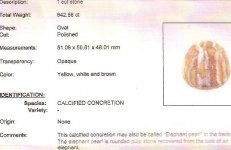sumavapersians
New Member
- Joined
- Aug 26, 2007
- Messages
- 6
elephant pearl forum, to Slraep
elephant pearl forum, to Slraep
Hi Slraep.
Sorry I didn't know anything about Zeide. I know am making lots of errors and want to apologize again!
Well, about your question, I never tell about my Gaja Muktha comes from.
I only took some pictures to show to members of this forum as I could share this pearl with everybody of all of you, NEVER to try to sell it. It's not for sale. I don't say somebody is saying that but wanted to clarify this point.
Another thing is this pearl is not human hand carved is a natural ivory bead. Somebody can believe it or not, is not my problem. I like it, it's all. I wanted to add this pearl is really antique, not "made" nowadays.
Ignacio
elephant pearl forum, to Slraep
Hi Slraep.
Sorry I didn't know anything about Zeide. I know am making lots of errors and want to apologize again!
Well, about your question, I never tell about my Gaja Muktha comes from.
I only took some pictures to show to members of this forum as I could share this pearl with everybody of all of you, NEVER to try to sell it. It's not for sale. I don't say somebody is saying that but wanted to clarify this point.
Another thing is this pearl is not human hand carved is a natural ivory bead. Somebody can believe it or not, is not my problem. I like it, it's all. I wanted to add this pearl is really antique, not "made" nowadays.
Ignacio


